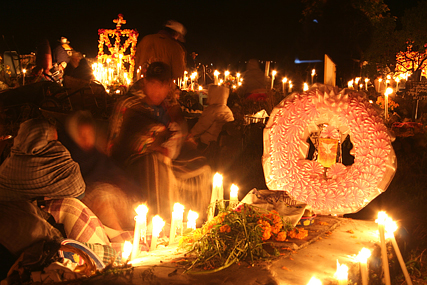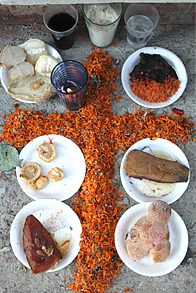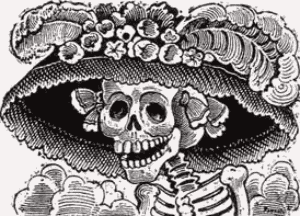

The Day of the Dead or Día de los Muertos is a holiday celebrated by people of Mexican heritage as well as others, mainly in Mexico, but also in the United States as well as other countries. On the 1st and 2nd of November, gatherings of family and friends pray for and remember friends and relatives who have died. The dates of November 1st and 2nd connect with the Catholic holy days of All Saints’ Day and All Souls’ Day. Some traditions include building private alters honoring the deceased, using sugar skulls, marigolds, and the favorite foods and beverages of the departed, as well as visiting graves with these as gifts.
Origins
The origin of the Day of the Deal celebrations in Mexico can be traced back to some of the indigenous peoples of the region, including the Olmec, Zapotec, Aztec and Maya, as well as others. These civilizations have been observing rituals celebrating the deaths of ancestors for a s long as 2500–3000 years. Before the arrival of the Spanish, people commonly kept skulls as trophies and displayed them during rituals to symbolize death and rebirth.
In most regions of Mexico, November 1st honors deceased children and infants (Día de los Inocentes or Día de los Angelitos) and adults are honored on November 2nd (Día de los Muertos or Día de los Difuntos).
 Beliefs Beliefs
It is the belief of many people that during the Day of the Dead, it is easier for the souls of the departed to visit the living. Therefore, people will go to cemeteries to communicate with the souls of the departed. There, they will clean and decorate their graves with ofrendas, or offerings which often include orange marigolds called cempasúchitl or Flor de Muerto (Flower of the Dead). These flowers are thought to attract the souls of the dead to the offerings. They will also build private altars containing the favorite foods and beverages, photos, and memorabilia of the departed. The intention is to encourage visits by the souls, so that the souls will hear the prayers and comments of the living directed to them.
Ofrendas are also put in homes, along with food such as candied pumpkin, pan de muerto (bread of the dead), sugar skulls, and beverages. The offerings are left out in the homes as a welcoming gesture for the deceased. Pillows and blankets are also left out for the the deceased to use to rest after their long journey. In some parts of Mexico, people spend all night beside the graves of their relatives.
As well as leaving offerings in the home, some families build small altars or shrines in their homes. These may contain the Christian cross, statues or pictures of the Blessed Virgin Mary, pictures of the deceased, along with candles. Families will spend time praying and telling anecdotes about the deceased around the altar. Some wear shells on their clothing so that they will create noise when they dance, waking up the dead.
 A common symbol of the holiday is the skull, which appears on masks, called calacas, and foods, such as sugar skulls and pan de muerto. Another image commonly associated with the holiday is José Guadalupe Posada’s La Calavera de la Catrina, a 1913 zinc etching parodying a Mexican upper-class female who is costumed with a skeleton face. A common symbol of the holiday is the skull, which appears on masks, called calacas, and foods, such as sugar skulls and pan de muerto. Another image commonly associated with the holiday is José Guadalupe Posada’s La Calavera de la Catrina, a 1913 zinc etching parodying a Mexican upper-class female who is costumed with a skeleton face.
Traditions and activities that take place during the Day of the Dead celebration vary from town to town as well as country to country. As well as in Mexico, the holiday is important for Mexican immigrants living in the United States. Celebrations in the United States are often very similar to those held in Mexico.
Information courtesy of Wikipedia |







